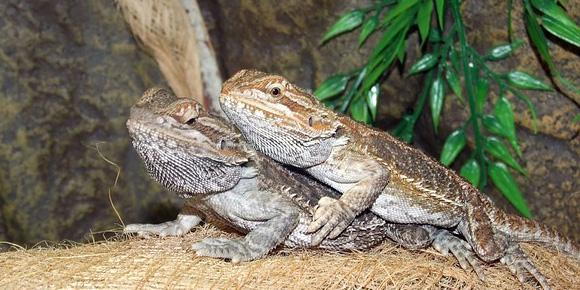
Caring for reptile and amphibian pets is very different from caring for your dog or cat. A reptiles’ or amphibians’ health is dependent on their environment much more than a cat or dog. This is because these animals require the proper heat, humidity, lighting, as well as specialized diets. It is also important to understand that each reptile or amphibian species comes from a different environment or has adapted to eat different foods. Therefore, it is important to know the natural history of the reptile or amphibian you are going to get and set their home and care regiment up accordingly. For example, if you are looking to get a turtle that lives in the water, you will want to setup an aquarium-like habitat with a basking area. In contrast if you are going to get a desert tortoise, you will want a land habitat with high temperatures and low humidity.
Heat
Reptiles and amphibians use heat from environment for many biological processes such as digesting food and fighting disease. Our mammal companions produce their own heat for these processes. If the enclosure is not warm enough the reptile or amphibian may become susceptible to infection or be unable to process their food and fall ill. If the enclosure is too warm they may overheat and die. Many reptiles require having an enclosure that is higher than room temperature, usually in the high 70s to lower 80s with a basking area in the high 90s to 100s. Again, this is variable depending on the species natural history. This heat is usually provided to the animals via a heat lamp, ceramic heating coil, or under tank heating pad. Many snakes can be housed with an under-the-tank heating pad under part of the cage, although under-the-tank heating is not recommended for lizards or turtles. Turtles that live in the water can be provided heat with a heat lamp over a basking area and a fish tank heater to keep the water in the low 70s. It is important to have a thermometer in both the warm and cool ends of the cage. Many amphibians require lower temperatures than reptiles, but they require higher humidity.
Humidity
Humidity is the amount of water vapor in the air. This is usually measured in relative humidity and expressed as a percent. Heat and relative humidity are opposite of each other. When humid air is warmed, it becomes dryer as it expands and vice versa. A hygrometer is an instrument that is used to measure relative humidity; at least one hygrometer should be in the enclosure to monitor the humidity. Many tropical species require humid warm environments, which can be challenging to achieve. Reptiles and amphibians will require high or low levels of humidity depending on where they are from. Amphibians usually require more humidity than reptiles because their delicate skin does not hold water as well. Having the wrong humidity for your pets’ enclosure can be catastrophic. If the humidity is too high the pet can contract skin infections or pneumonia. If the humidity is too low, the pet may dehydrate and die. There are many ways to provide humidity to your pets. Some pets that require low humidity will be satisfied with a water bowl, others that require higher humidity may need a larger water bowl and need to be misted. For some species, such as dart frogs or salamanders, an automatic misting system may be needed to keep the humidity at a constant high level.
---
Should you have any questions, comments or concerns, please don't hesitate to contact us by phone at 845-876-6008, or by e-mail at [email protected].
Thank you for continuing to trust Rhinebeck Animal Hospital as part of your pet's health care team!
With warmest regards,
Your friends at Rhinebeck Animal Hospital
